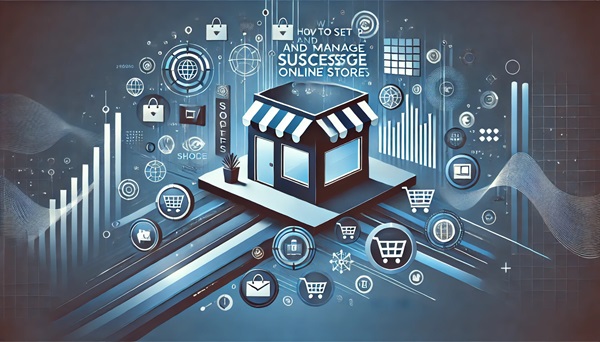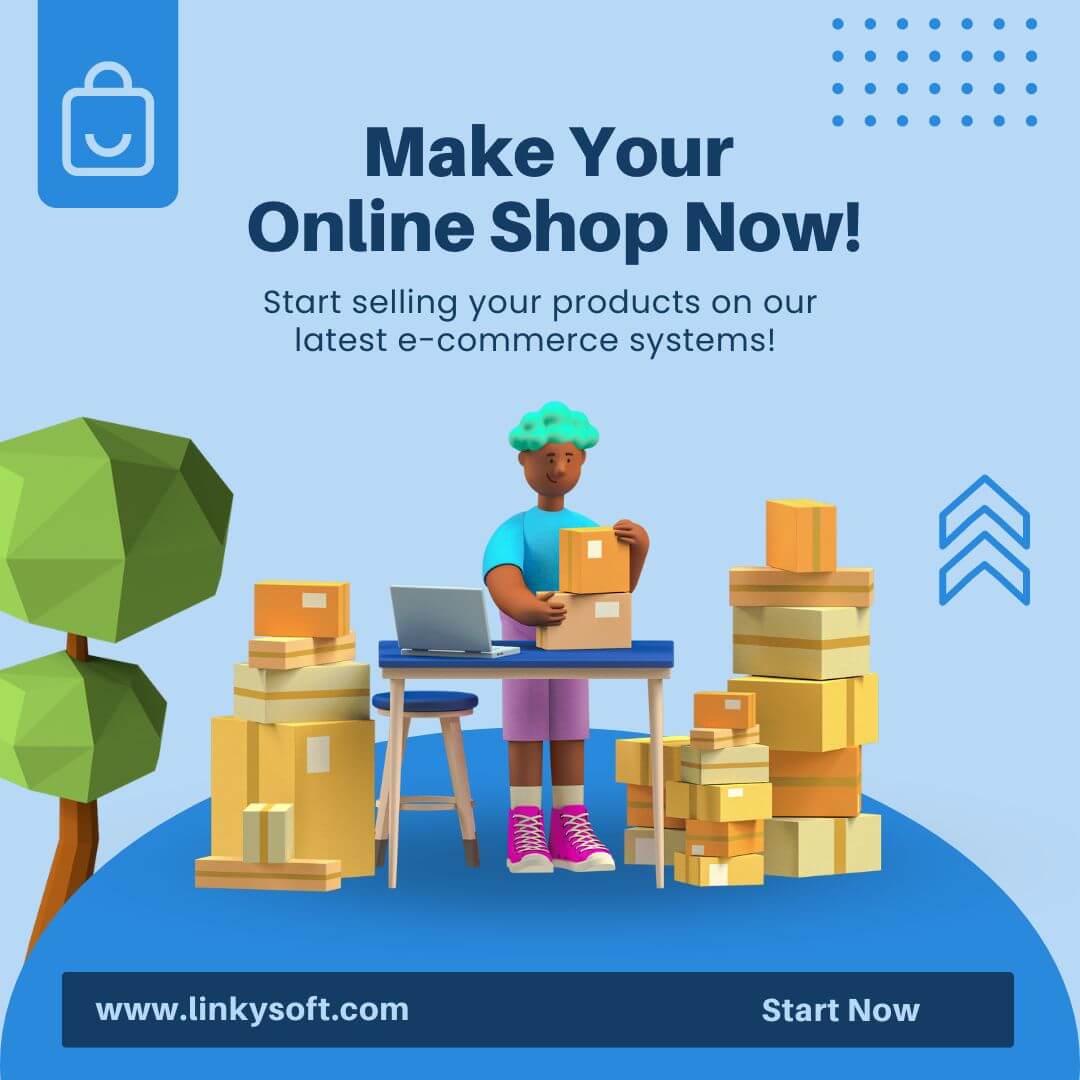In today’s rapidly evolving digital landscape, establishing a successful online store is a dream for many entrepreneurs and businesses. However, building an online store that stands out and thrives requires much more than just a digital presence. From choosing the right platform, ensuring seamless functionality, and delivering an exceptional customer experience, managing a successful e-commerce business involves strategic planning and continuous improvement.
we will explore how to set up and manage successful online stores, diving deep into the best practices, tools, and techniques that will help you grow your online business sustainably. Using our expertise at Linkysoft, we’ll also explore how our advanced e-commerce solutions, such as Cartz and Togar, can help you achieve e-commerce success.

1. The Evolution and Importance of E-Commerce
Understanding E-Commerce Growth
E-commerce has transformed the way people shop, providing unprecedented convenience and access to a global marketplace. According to Statista, global e-commerce sales are expected to reach $6.5 trillion by 2024, highlighting the massive opportunity for businesses to tap into this growing market. The shift to online shopping is not just a trend but a fundamental change in consumer behavior, accelerated by the COVID-19 pandemic and advancements in technology.
The Shift from Traditional to Digital Commerce
With more consumers opting to purchase goods and services online, businesses have had to adapt quickly. Traditional brick-and-mortar retailers are now transitioning to omnichannel strategies, where their online and offline operations are integrated to provide seamless shopping experiences. The growth of mobile commerce, or m-commerce, has also significantly impacted how businesses operate, as more customers shop using smartphones and tablets. Therefore, understanding the dynamics of both traditional and digital commerce is crucial for any e-commerce venture.
2. Choosing the Right E-Commerce Platform
Why Your Platform Matters
Choosing the right e-commerce platform is the cornerstone of a successful online store. With so many options available, from simple website builders to comprehensive e-commerce management systems, the decision can be overwhelming. The right platform should provide you with the flexibility to scale, the features to support your growth, and the tools to manage everything from inventory to marketing.
Linkysoft’s e-commerce systems offer a range of solutions, including Cartz for single-vendor stores and Togar for multi-vendor setups, allowing businesses of all sizes to build and manage their stores with ease.
Features to Look For in a Platform
When choosing an e-commerce platform, consider the following essential features:
- Customizability: The platform should offer customizable templates and themes to align with your brand identity.
- Scalability: As your business grows, the platform should be able to accommodate increased traffic, products, and sales without performance issues.
- Security: Robust security features, including SSL encryption, fraud protection, and compliance with regulations like GDPR, are essential to protect your business and customers.
- Integration with Third-Party Tools: The platform should integrate easily with marketing tools, payment gateways, and shipping providers to streamline operations.
- Support for Mobile Commerce: Mobile-friendly designs and features are critical, as an increasing number of consumers shop via smartphones and tablets.
SaaS vs Self-Hosted Platforms
There are two primary types of e-commerce platforms: Software as a Service (SaaS) and self-hosted. SaaS platforms like Shopify or BigCommerce offer convenience and ease of use, as the provider handles hosting, security, and updates. On the other hand, self-hosted platforms like WooCommerce and Magento give you more control and flexibility, but require more technical knowledge and responsibility for hosting and maintenance.
Why Linkysoft E-Commerce Solutions Stand Out
Cartz by Linkysoft and Togar provide the best of both worlds. These systems offer the flexibility and control of self-hosted solutions combined with the ease of use and scalability of SaaS. Whether you're running a single-vendor store or a multi-vendor marketplace, Linkysoft’s systems are designed to help you scale efficiently while maintaining full control over your e-commerce operations.
3. Setting Up Your Online Store: Step-by-Step
Choosing a Domain Name and Hosting
Your domain name is the first point of contact with your potential customers. It should be short, memorable, and reflect your brand’s identity. Platforms like Namecheap and GoDaddy provide domain registration services.
Hosting is another crucial factor that affects the performance and reliability of your online store. Many e-commerce platforms come with built-in hosting, but if you're using a self-hosted solution, you’ll need a reliable hosting provider. Look for hosting services that offer speed, security, and scalability. Popular options include Bluehost and SiteGround.
Designing a User-Friendly Interface
First impressions matter. The design and layout of your store can significantly impact customer engagement and sales. A well-designed store should be visually appealing, easy to navigate, and optimized for mobile devices. Many platforms offer pre-designed templates that you can customize, or you can hire a professional designer to create a unique design that aligns with your brand.
4. Organizing Products and Categories
Importance of Product Categorization
Organizing your products into categories helps customers find what they’re looking for quickly and easily. Use clear, descriptive names for categories and ensure that each product is placed in the appropriate category. For example, if you’re selling electronics, you could create categories like “Smartphones,” “Laptops,” and “Accessories.”
Effective categorization not only improves user experience but also helps with SEO, making it easier for search engines to index and rank your products.
Product Descriptions and Images
High-quality product descriptions and images are essential for converting visitors into customers. Each product listing should include detailed information about the item, including features, specifications, and benefits. Use bullet points for clarity and include the target keyword “How To Set Up And Manage Successful Online Stores” naturally in your descriptions.
Product images should be high-resolution and show the product from multiple angles. If possible, include videos or 360-degree views to give customers a better idea of what they’re buying.
5. Managing Inventory and Orders
Inventory Management Systems
Inventory management is crucial for maintaining a successful online store. An efficient system helps you avoid stockouts, overstocking, and errors in order fulfillment. Many e-commerce platforms come with built-in inventory management tools, but you can also use third-party solutions like TradeGecko or Lightspeed to manage your inventory.
Linkysoft’s Togar system offers advanced inventory management features that allow you to track stock levels, automate reorder processes, and integrate with suppliers for real-time inventory updates.
Order Fulfillment Strategies
Efficient order fulfillment is key to ensuring customer satisfaction. Whether you’re handling fulfillment in-house or using a third-party logistics provider (3PL), it’s important to have a system in place that tracks orders from the moment they’re placed until they’re delivered.
Offering multiple shipping options, such as standard, expedited, and international shipping, gives customers flexibility and improves their overall shopping experience. You can integrate with shipping carriers like UPS or FedEx for automated shipping calculations and tracking.
6. Optimizing Your Online Store for Search Engines
SEO Best Practices
Search engine optimization (SEO) is essential for driving organic traffic to your online store. By optimizing your website’s content and structure, you can improve your ranking on search engines like Google, increasing visibility and attracting more customers.
Here are some key SEO strategies for online stores:
- Keyword Research: Use tools like Ahrefs or SEMrush to identify relevant keywords for your industry and products. Incorporate these keywords into your product descriptions, blog posts, and meta tags.
- Optimizing Meta Tags: Meta titles and descriptions should be concise, compelling, and include your target keywords. These tags are important for both SEO and user experience, as they are often the first thing a potential customer sees in search results.
- Building Backlinks: Backlinks from reputable websites signal to search engines that your site is trustworthy and authoritative. You can build backlinks through guest blogging, partnerships, and influencer outreach.
- Improving Site Speed: A fast-loading website is critical for both user experience and SEO. Use tools like Google PageSpeed Insights to identify areas where you can improve your site’s loading time.
Local SEO and International SEO
If your online store serves a local market, optimizing for local SEO is essential. This includes creating a Google My Business profile, encouraging customer reviews, and using location-specific keywords in your content.
For businesses targeting an international audience, international SEO strategies involve creating content tailored to different languages and regions, using hreflang tags to indicate the language and geographic targeting of web pages, and ensuring that your website complies with international regulations like GDPR.
7. Enhancing Customer Experience
The Importance of UX/UI Design
A seamless user experience (UX) and user interface (UI) design are crucial for keeping customers on your site and guiding them toward making a purchase. Navigation should be intuitive, the checkout process should be simple, and all product pages should be easy to read and interact with.
Many e-commerce platforms, including those offered by Linkysoft, provide pre-built templates designed with UX in mind, allowing you to focus on optimizing content and driving sales rather than worrying about design from scratch.
Providing Excellent Customer Support
Customer support is a major factor in ensuring repeat business and positive reviews. Offering multiple channels for customer support, such as live chat, email, and phone support, can help resolve issues quickly and enhance the overall shopping experience. Additionally, consider adding a comprehensive FAQ section to address common questions and reduce the number of support inquiries.
8. Marketing and Promoting Your Online Store
Leveraging Social Media
Social media is a powerful tool for promoting your online store and engaging with customers. Platforms like Facebook, Instagram, and Pinterest offer a variety of advertising options, including targeted ads, product tagging, and shoppable posts.
Engaging content, such as behind-the-scenes videos, product tutorials, and customer testimonials, can build brand awareness and foster a loyal community of customers.
Email Marketing Campaigns
Email marketing remains one of the most effective ways to convert leads into customers and retain existing customers. Build an email list through opt-ins on your website and social media, and segment your audience based on their preferences and buying behavior.
Regular newsletters, product updates, and personalized promotions are great ways to keep your customers engaged and drive repeat sales.
9. Analyzing Data and Optimizing Performance
Tracking Key Performance Indicators (KPIs)
Data analysis is crucial for understanding how your online store is performing and identifying areas for improvement. Key performance indicators (KPIs) such as conversion rates, customer acquisition costs, and average order value provide insights into your store’s success.
Use analytics tools like Google Analytics or the built-in reporting features of your e-commerce platform to track KPIs and make data-driven decisions.
Testing and Experimentation
Constantly test different elements of your online store to see what works best for your audience. A/B testing product pages, checkout processes, and marketing campaigns can provide valuable insights and help you optimize your store for better performance.
10. Scaling Your Online Store for Long-Term Success
Expanding Your Product Range
As your online store grows, consider expanding your product offerings to attract new customers and increase revenue. However, before launching new products, conduct thorough market research to ensure there’s demand for your offerings.
Test new products with a limited release to gauge customer interest, and use data from previous sales to identify trends and preferences.
Adopting Multi-Vendor Solutions
For businesses looking to expand further, adopting a multi-vendor platform like Togar Pro allows you to create a marketplace where multiple vendors can sell their products through your website. This model not only increases the variety of products available to your customers but also opens up new revenue streams for your business.
Conclusion
Building a successful online store requires careful planning, the right tools, and continuous improvement. From choosing the right platform to optimizing customer experience and marketing strategies, every aspect of your store should be geared toward providing value to your customers and driving sales.
With comprehensive e-commerce systems like those offered by Linkysoft, businesses of all sizes can set up, manage, and scale their online stores efficiently and effectively. By following the strategies and best practices outlined in this guide, you’ll be well on your way to creating a thriving e-commerce business that stands out in a competitive digital landscape.








